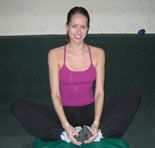With all the weight training, do you find yourself getting slower in the delivery of your kicks? There is a point when to much bulk starts to interfere with delivery and flexibility.
No, on the contrary—strength training any muscle group increases the motor neuron groups that activate the muscles to fire with increasing synchronicity, which means they can react
faster the stronger you get. There are a number of sports physiology studies I've read which suggest that this increased synchronicity is the first phase of any strength gain from resistance training, and persists throughout the training routine. There is, in contrast, no evidence I'm aware of that larger muscles are slower, or less flexible. Some of the most powerfully built athletes, professional basketball players, are also amongst the quickest and most limber there are. And if you look at the musculature of sprinters and gymnasts, you'll have plenty of reason to question this particular bit of what I think is just gym folklore.
People often bring professional bodybuilders into this discussion, but that's a big mistake: pro builders, who in almost all current and recent cases use anabolic steroids and growth hormone to reach the size and proportions they do, have massive muscles as a result but do not have accompanying connective tissue growth, because tendonds, ligaments and the other controlling fibres that actually allow you to move the muscles do not themselves grow even when the muscles get huge. So pro builders tend to have surreal physiques, but not the connective tissue backup for them. That's very different from developing considerable strength and muscle volume from completely natural training, where everything will stay in proportion. If your strength/size gains come from resistance training pure and simple, you will get faster, not slower.
I think we are getting away from the original question here though. The original question was about not being flexible enough to kick high. Not being strong enough and flexible enought to kick high and hold it.
But strength is critically important if you want to be able to assume certain physical positions in which to carry out the necessary stretching in the first place. It's not enough to stretch; you need to stretch in the positions that you're hoping to be able to assume. So the flexibility to kick high, for example, involves stretching in a configuration where you're able to
reach a high point with your foot, and work the hip muscles in that position, just as you do for any other dynamic stretching exercise, a la Kurz's approach.
If you can develop the strength to kick to a middle height and hold it there, you'll be strong enough to get your let up to that point, and then raise it a little higher, and do the kicks in slow motion that you ultimately want to do rapidly. And when you can do that, you can go a little higher. But if you can't ever get enough flexor strength to reach the target position in which you want to do the stretch, then you'll never be able to maintain the configuration in which the flexor muscles get to stretch out. That's why I think that strength, balance and flexibility all have to be developed in tandem, when it's a matter of improving your kicking.


